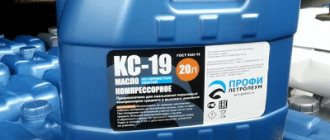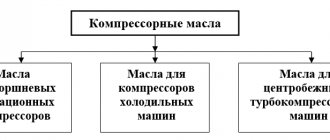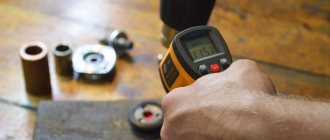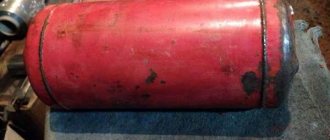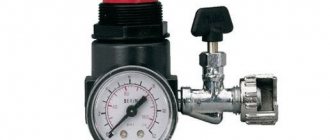The compressor is a reliable assistant for a small home workshop, car service center and large production. Piston models require constant lubrication of the moving parts of the piston group. The oil is changed periodically, following the manufacturer's recommendations. Between servicing it must be topped up as it is used up.
Oil for air piston compressor
Oil in a piston compressor is the main consumable. It is designed to solve the following problems:
- lubrication of moving parts, reduction of friction;
- cooling of piston group parts;
- anti-detonation;
- additional sealing of working chambers.
If a decrease in tightness only reduces the performance of the unit, then insufficient lubrication or overheating can lead to failure of the unit, costly repairs, or even an accident. Therefore, the owner is obliged to monitor the level and replenish its supply as it is consumed.
Myth #3: An industrial compressor can be used in a continuous production cycle.
Even an industrial compressor is not designed for continuous use. Even more durable screw-type devices will not withstand such a load.
The classification of piston compressors into industrial, semi-professional and household is based not on their ability to withstand certain loads, but on design features. Industrial compressors differ from household and semi-professional compressors by a belt drive and can only be oil-powered, while lower-class devices can also be oil-free with a direct drive. This is what allows industrial compressors to be used more intensively, but this does not mean that they can work around the clock.
Oil change: rules and recommendations
Manufacturers of compressor equipment always indicate in the user manual which brands of oils can be used for replacement in a given model. Global brands even produce brands of lubricant under their own name.
Important! Automotive compressor lubricants can be used for replacement in the compressor crankcase in case of extreme need. It is intended for other operating modes, temperature, pressure.
Prolonged use may damage the compressor. After short-term use, you should immediately change the oil to the recommended one.
In the manual, in addition to the main recommended brand, one or two compatible ones must be indicated for replacement. If it is not available, you can replace it with a lubricant for compressors of any global brand. It will cost more, but is guaranteed not to harm the unit.
When changing the compressor oil, follow the instructions in the owner's manual for your specific model. Experts have formulated several general recommendations:
- Be sure to turn off the power to the device before starting replacement;
- relieve pressure.
- Unscrew the plug and drain the old grease into the prepared container. It is better to take a flat cuvette with a capacity 1/3 larger than the rated oil volume.
- Some models are recommended to be tilted towards the drain hole.
- After the oil has completely drained out, carefully tighten the plug. Wipe off any splashes that might get on the body.
- Fill with new lubricant to the normal level.
A slightly increased amount of oil must be poured into piston compressors - part of the lubricant will be distributed over the surfaces of the parts.
The waste must not be poured onto the ground or down the drain; this will lead to serious environmental pollution. It must be submitted for recycling to specialized receiving organizations.
Be sure to completely change the oil in the compressor. A mixture of clean lubricant with contaminated lubricant, especially of different types, leads to increased wear of unit parts. It is strictly forbidden to mix synthetic and mineral varieties.
Myth No. 2: Oil for internal combustion engines is also suitable for compressors.
This is one of the most common misconceptions that exists in many car services. Its logic is based on a similar principle of operation of a piston compressor group and an internal combustion engine. But this is not a reason to use motor oil instead of compressor oil. All self-respecting manufacturers of automobile oils have products for compressors in a separate product group. It is easy to make sure that compressor oil differs from other types of oils - just compare the characteristics of different types of products.
Compressor oils are superior to automobile oils in terms of kinematic viscosity and flash point in an open crucible. In addition, it is strictly forbidden to mix oils of the same type and with similar characteristics if they are produced by different manufacturers. Compressor oil must be completely drained and replaced with new oil when switching to a new brand of product.
What kind of oil to pour into a piston compressor
To avoid breakdowns, the choice of lubricant should be taken seriously. High-quality products will ensure full rated performance, operational stability, as well as a long service life of the unit. One of the most important indicators of lubricant quality is its viscosity. It is measured in laboratories and determines the ability of a material to linger on lubricated surfaces. Viscosity should not be less than seven conventional units. Such a lubricant will envelop the parts and components of the unit, primarily the piston rings and crankshaft bearings, reducing friction between them.
The next indicator is the pour point. In summer and in heated rooms, it is quite acceptable to use cheaper varieties with high temperatures. If the compressor will be used outdoors in winter, it should be replaced with low-temperature lubricants.
Source
Lubricant selection
If the oil meets the technical requirements, the compressor will operate for a long time and stably. Air models (piston and screw) require oil with a high viscosity coefficient. For high-quality lubrication, the indicator must be more than 100 units. Do not use machine oil in air units; this will damage the system and may lead to an emergency.
Special oils with a narrow focus are available for sale; you can always choose the required budget option. The first replacement should be carried out after 50-100 hours of operation (depending on the power of the sample). During the startup period, the piston group grinds in, harmful lubricant components appear, which should be gotten rid of. All subsequent replacements are carried out according to the instructions or more often, with increased loads on the compressor.
Experts advise opening the canister as little as possible and pouring the filler into different containers. Contact with oxygen and atmospheric moisture significantly impairs the consumer properties of consumables.
Common domestic oils include compressor brands KS-17, KS-19 and TNK VDL 100. Almost all well-known world brands produce lubricants for compressed air installations, for example, VDL 100 Fubag and Addinol VDL 100.
Classification of compressor oils and their scope
All modern compressors are divided into two main types, differing in their design and operating features. These include:
- Volumetric. In such equipment, the distilled gaseous substance is sucked into the working chamber, compressed and thrown out under pressure by the forward-return movement of the piston system;
- Dynamic. The compression of the medium they distill is carried out using turbine mechanisms. The intake gas is accelerated by the turbine rotors, after which it suddenly slows down, causing it to be dynamically compressed.
In volumetric piston compressors, oil provides lubrication of moving parts - piston group, valves, bearings. Traditionally, such models use mineral oil that meets international certificates DIN-51506-VGL, VDL. The viscosity class for them corresponds to ISO/VG standards from 68 to 150. In positive displacement rotary or screw compressors, the moving parts are lubricated using an oil bath. As a result, the oil is constantly mixed with the forced air, heating to a temperature of about 90-100ºC.
At the outlet of the compressor chamber, a filter device is installed that separates the oil from the gaseous substance. Therefore, for use in rotary and screw compressors, oils with increased deaeration and demulsification characteristics are used.
Special requirements are also imposed on increased anti-corrosion properties and the maximum amount of deposits during operation. Most manufacturers of such equipment provide instructions in the accompanying instructions regarding the selection of a suitable lubricant.
In dynamic modifications of compressor units, lubrication is provided through a forced supply circuit: gears, shaft seals, bearings. It is recommended to use the same type of oil for the compressor operating mechanism and its drive system. It is recommended to use special turbine oils of the following grades in dynamic installations that comply with the ISO/DP-6521 standard:
- DIN-51-515 TDL-32;
- TDL-46;
- TDL-68;
- TDL-EP with extreme pressure additives.
Conventional motor oils are classified according to their flash point.
Compressor lubricants are divided, unlike motor lubricants, according to the temperature of the pumped substance.
In Russia, along with the international classification of compressor oils, the domestic classification adopted by Gostekhnadzor back in Soviet times is still often used.
According to it, all compressor oils are divided into 4 groups:
- Lubricant intended for operation under moderate loads. The temperature of the discharge gas does not exceed 160ºC.
- The second group is intended for operation under moderate loads, but with a discharge gas temperature of up to 180 degrees.
- Compressor lubricant of the third group is designed for mechanisms operating under increased loads and temperatures up to 200ºC.
- The last group includes oils intended for operation in extremely difficult conditions, with increased pressure and temperatures up to 200ºC.
Each group has a special list of operational and technical properties that must be taken into account when choosing the type of oil for the compressor.
It should be noted that foreign manufacturers have not developed a unified classification for operating temperature, and each large company uses its own standards.
Compressor oil compatibility table
| Ether* | PAG | PJSC | Group III synthetic oil | Mineral oils of group I and group II | Silicone base oil | |
| Ether* | Yes | No | Maybe | Maybe | Maybe | No |
| PAG | No | Yes | No | No | No | No |
| PJSC | Maybe | No | Yes | Maybe | Maybe | No |
| Group III synthetic oil | Maybe | No | Maybe | Yes | Maybe | No |
| Mineral oils of group I and group II | Maybe | No | Maybe | Maybe | Yes | No |
| Silicone base oil | No | No | No | No | No | Yes |
It is impossible to answer for sure whether one oil will be compatible with another, since it is always worth considering incompatibility with additives and the degree of contamination of the oil during operation. When changing oil in compressors, we strongly recommend draining the old oil and flushing the system, regardless of what base oils are included in the old and new oils, since there is always the possibility of incompatibility. This conservative recommendation is also based on a risk-benefit model when it comes to tank size; tanks tend to be small in size. So, due to the fact that the container contains a small volume of oil, i.e., its loss in the process of removing its residues will be minimal, draining the oil and flushing the system should be carried out taking into account all risks and compatibility aspects.
The risk of contamination can be reduced not only by draining the old compressor oil, but also by flushing the system and replacing filters. To get the most out of your new compressor oil, it's not enough to simply add oil to the system, which is why we recommend going through the replacement procedure from start to finish, including draining the oil, flushing and replacing filters.
This procedure not only reduces risks, but also improves equipment performance.
In some cases, the services of technical specialists may be required. If the question arises about removing carbon deposits and varnish deposits, it is worth thinking about the incompatibility of oils. In this case, it is necessary to flush, possibly using solvents, replace seals, etc.
We bring to your attention recommendations for washing. These can be used as requirements to complement OEM requirements.
Oil review - brief description of oils from different manufacturers with prices
Compressor oil is a rather specific material, designed specifically for narrow-profile use. Manufacturers strongly recommend using only high-quality, certified product to achieve the best performance of their products. Among the high-quality and inexpensive oils, the following names can be distinguished:
Unlike the ones above, the following oils are more common and can be purchased online from the comfort of your home.
Oil change procedure
The manufacturer's recommendations relate to the end of the working life and maintenance of equipment. Meanwhile, accompanying manipulations, for example, cleaning and checking system components, are no less important.
Residues of old oil and accumulated metal particles in the piston circuit reduce the efficiency of the device and lead to emergency stops.
If you are about to begin the procedure, listen to the following tips:
To clean the circuit as much as possible, it is necessary to run the product to warm up and then drain the oil. If there is no drain plug, the waste is removed through a level control device. The compressor tilts until it is completely free of waste, at the same time the filler hole must be open.
After draining, it is necessary to unscrew the piston chamber cover and thoroughly clean the opened space. First, the internal surfaces are cleaned with a brush moistened with gasoline, then with a dry rag. The check valve and air filter must be cleaned.
Fresh filling is done through a special hole with a dipstick to determine the level. After replacing, they do not start working for about an hour, since the oil needs to settle.
In practice, the volume of the fill is measured by the amount of filler drained. Safety precautions must be followed to avoid contact of waste material with the skin.
The procedure itself is not difficult; the main thing is to use oil that has been tested and recommended by the compressor manufacturer.
Helpful advice
Have you bought a new compressor? Buy a big magnet! Hang it on the oil sump in the area of the compressor inspection eye. When it's time to change the oil, remove the magnet. Due to the grinding of the piston group elements, metal shavings will accumulate on the inside of the crankcase. After draining the oil, all debris will go away. Done? Now attach the magnet back and add fresh oil!
changing the oil in the compressor
,
choosing oil for a piston compressor
Myth #9: Moisture and oil in compressed air are a sign of trouble.
The presence of moisture and oil in compressed air is not a sign of a compressor malfunction.
The volume of oil gradually decreases due to natural entrainment; this is a completely normal process. The presence of moisture in compressed air is also normal, unless the compressor operates next to a dryer. And installing a moisture separator or cyclone separator still will not ensure complete removal of moisture.
An oil-free compressor, contrary to popular belief, does not produce air of a higher degree of purity. Of course, there will be no oil in it, but moisture will still be released. At the same time, it will come into contact with the internal working surfaces and lead to the formation of rust. Only expensive medical compressors equipped with an anti-corrosion coating are protected from this.
In any garage, an air compressor should occupy the most honorable place, because after it appears on the farm, its owners remember with horror the times when they had to manually unscrew soured nuts and blow out the carburetor using their lungs. But, with the advent of this most useful device, life changes for the better. The most common air compressors come in two designs: screw and piston. A screw compressor consists of a housing, inside of which there is a compression chamber, two worm shafts and a motor. The basis of this design is the shafts through which air is pumped.
Read also: Adjusting the carburetor of the Taiga 214 chainsaw
They are located almost right next to each other, but do not touch - tightness, due to which the compressed air does not “leak” out, is achieved using an oil film on their surface. A piston compressor can have many more components and parts than a screw compressor. A piston is used as a supercharger, which during movement draws in air using an inlet valve, and during the translational movement of the piston, air is supplied through the injector to the receiver.
In both cases, system lubrication plays an important role, since without a good oil film, compressor performance decreases sharply .
Oil change is shown in the video
When do you add oil and when do you change it?
It’s not difficult to determine when it’s time to add lubricant. It is enough to pay attention to the mark indicating what oil level should be in the compressor. The mark is usually located along and serves as a guide. If the level is below the mark (or colored dot), it’s time to top up.
In older compressor models, instead of a window with a mark, a drain pipe was installed in the middle part of the crankcase: oil was added until it came out of it, that is, it was impossible to visually determine its level.
The total volume of the crankcase, that is, how much oil is needed for one filling, is sometimes indicated in the accompanying documentation for the air compressor, sometimes not. In different models this volume ranges from 0.3 l to 0.9 l. Thus, one liter bottle of compressor oil (the most common volume on sale) is enough for both refueling and topping up. The average cost of a high-quality composition is about 400 rubles. per liter
An important point: you should add compressor oil of the same brand that is already in the crankcase. It is unacceptable to mix two types of lubricant, much less dilute compressor lubricant with motor lubricant.
In addition to differences in viscosity, the mixtures have a different set of additives.
Mandatory replacement of lubricating fluid with “fresh” fluid is carried out after the first 50 hours of operation (you will have to keep records of engine hours worked). The first filling is involved in the grinding process of moving parts and washes out the smallest particles of debris from the joints. By the type of oil being drained, you can judge how well the operating modes of the air compressor are adjusted: cloudy whitish color - moisture gets into the crankcase, dark (moderate) - practically normal, too black - it is advisable to flush the crankcase. For washing, use the recommended composition, but if you are sorry, you can use an inexpensive motor one, let the device run for 15 minutes, then drain it.
Changing and adding oil can only be done with the compressor turned off and air bled (pressure gauge at zero).
In the future, a complete replacement is made after 200-300 hours. Instructions for changing the lubricant must be included with the compressor upon sale. It describes or shows graphically what to unscrew when draining, where to fill and how often.
With careful attention to the equipment, timely maintenance prescribed in the operating instructions, and the use of the oil brand recommended by the manufacturer, the compressor will last for decades.
How much oil should there be in a refrigerator compressor?
The Nord refrigerator has broken down with symptoms - it is trying to start, silence and humming, after 10 seconds there is a click and silence. And so on in a cycle. In principle, it became clear immediately that the problem was in the compressor, it was jammed, and with a click the thermal protection relay turned it off. The compressor itself was removed from the refrigerator before disposal (repair was considered impractical):
On the table, the compressor was started every other time, without developing pressure, without creating a vacuum. Therefore, it will be used for dissection for educational purposes, which I hasten to share.
This device is wonderful for many reasons.
Firstly, the compressor is completely sealed, and the motor is located inside a sealed space, and does not enter the shaft through an oil seal or some other seal. This greatly simplifies the seals, making leaks uncritical - everything stays inside.
Secondly, the lubrication system - the motor and cylinder work in an oil bath, are lubricated with oil, and cooled with it.
Thirdly - a resource - at our department we have a refrigerator that has been working for more than 50 years, of course it knocks when starting up until it collects oil, but it works and freezes.
Fourthly, quiet operation due to tightness and installation of the engine on spring suspensions. Anyone who has heard how piston compressors work knows that there is nothing to do with them at home.
According to the principle of operation, it is a piston pump, similar to a car pump, which is used to inflate wheels.
The motor contains two windings - starting and working. The motor is asynchronous, and to operate it requires a rotating magnetic field, which is created by a pair of windings (they have different inductances, so there is no need for an additional capacitor, as when starting three-phase motors from a single-phase network). The starting winding is connected during startup, and overload protection is provided by a starting protection relay.
The posistor starting relay contains a washer made of a material that increases its resistance when heated by the current passing through it and turns off the winding. Overload protection - bimetallic strip at the bottom of the relay
External view of the compressor without a cover:
To make it clearer, I made an animated picture:
The piston does not contain sealing rings; the tightness of the cavity is ensured by a small gap and oil. Freon and oil inside are not separated and are in free contact.
And here is the reason for the lack of pressure - the oil has coked and settled on the petal valves
The reason is overheating.
Why are there 4 pipes? This compressor model has additional oil cooling - tropical version.
Even the winding band burst due to overheating:
Actually, why do you need a refrigerator compressor in a household? After certain manipulations (adding a receiver, filter, oil separator, pressure switch, housing) you can get a compact, and most importantly silent source of compressed air - for operating an airbrush, burner, etc. There are special silent compressors, and since the performance of one compressor from a refrigerator is small, they use them in packs:
Since the compressor has a suction pipe, it can receive vacuum, but that’s a completely different story.
Special compositions for piston compressors
Many users are wondering what kind of oil to put into a piston air compressor. It has special requirements. After all, the lubricant has to be in close contact with the compressed gas, which is very hot. Therefore, the oil must be safe even when heated to high temperatures - +170 +180 °C or more.
Attention!
Long-term use of oil leads to an increase in its density due to evaporation of the liquid and increased contamination. This may cause a fire and should be replaced regularly.
Because of this, the composition should include only high-quality additives, thanks to which the risk of carbon deposits on the moving parts of the engine can be eliminated. In addition, it must have high resistance to temperature oxidation. Otherwise, the risk of compressor failure increases.
Prices for compressor oil for piston compressors
compressor oil for piston compressors
Special compositions for screw models
- Start the compressor and allow it to run at normal operating temperature for at least 1 hour.
- Stop the compressor, turn off the power, relieve pressure, take an oil sample.
- Drain the compressor oil from the main reservoir, cooler, separator tank and lower piping system.
- Replace filters.
- Fill the main reservoir with Texaco compressor oil to the correct level.
- Repeat steps 1-5.
- Start the compressor and allow it to operate normally /Take an oil sample.
Submit the sample to Starlube technicians to evaluate the effectiveness of flushing/replacement. Repeat steps 1-5 if necessary.
Compressor maintenance requirements
Before carrying out work, you must make sure that the compressor is disconnected from the power supply and that the pressure gauge shows zero pressure.
The optimal maintenance schedule is every 500 hours of equipment operation. In addition to standard EO work, maintenance includes:
- checking the oil level and the formation of dust or oil deposits - if this is detected, it is necessary to clean the equipment;
- cleaning or blowing out the radiator with compressed air;
- checking the cleanliness of the oil (there should be no intense darkening);
- checking the functionality of electrical equipment, wiring and terminal connections.
Please note that the first change of oil and, accordingly, the oil filter should be carried out after the first 500 hours of operation of the equipment, that is, after its “break-in”. If the installation has not been put into operation (“equipment downtime”), then the oil must be changed one year from the date of manufacture of the compressor.
The oil change is carried out according to the following scheme:
- you need to remove the right wall of the compressor;
- turn on the equipment so that the oil warms up to a temperature of 70 degrees;
- turn off the compressor;
- remove the plug and gradually open the oil drain valve (to receive the waste liquid, prepare a container in advance);
- remove the old oil filter and replace it with a new one;
- turn the screw block pulley approximately 3-5 turns (the direction is indicated by the arrow on the end surface);
- close the tap and then pour oil through the oil filler neck, monitoring the fill level using the oil indicator;
- close the filler hole with a plug;
- turn on the compressor and leave it running for 1-2 minutes until the oil temperature approaches 70 degrees, then turn off the installation and add oil if necessary;
- mount the right wall of the installation.
It is better to invite an experienced specialist to change the oil in the compressor.
To ensure correct operation of the installation, you should use oil for screw compressors with the following technical indicators:
- viscosity - 46 cSt at a temperature of 40 ° C;
- minimum pour point temperature - from -8 to -10 ° C;
- flammability point temperature is more than 200 °C.
It is not recommended to mix oil from different manufacturers and brands.
After every 2000 operating hours, it is necessary to replace the air filters, check the belt tension and, if necessary, adjust it, and also check the tightness of the pipeline.
After every 4000 hours of operation of the unit, it is necessary to change the oil separator filter, change the oil and oil filter, check the safety valves, clean the radiator, check the condition of the belts and, if necessary, replace them with new ones, and also check the condition of the receiver.
If the compressor is installed in a dusty room, it is recommended that maintenance operations be carried out more frequently, paying the greatest attention to cleaning the radiator.
Additional recommendations when changing oil:
The oil drain valve is located at the bottom of the oil sump and is used to drain used oil. If necessary, condensate is also removed through this tap. The valve of the oil removal valve should be opened and closed only if the installation is turned off and there is no pressure inside the housing.
The oil level is monitored visually; the maximum oil level should not be higher than the upper cut of the inspection window, the minimum should be the lower cut (under the condition of a “cold” installation).
Maintenance operations:
- Replacing the air filter (after every 2000 hours of operation) - if the replacement frequency is not observed, the service life of the screw unit is reduced.
- Oil change (after every 4000 hours of operation, but at least once a year) - the first oil change is carried out after a “trial” period of operation after (500 hours). Oil is poured into the unit through the oil filler hole located on the oil sump body and closed with a special cap. The lid can only be opened if there is no pressure in the housing.
- The oil separator filter is replaced after every 4000 operations of the unit, but at least once a year.
- Oil filter replacement - carried out after every 4000 hours of operation, but at least once a year, the first replacement should be carried out after 500 hours of operation.
- Belt replacement is carried out after every 4000 hours of operation. After the first 50 hours, and then every 2000 hours, it is necessary to check the belt tension level and tighten them using a special adjuster.
To replace the belts you need:
- remove the protective fence;
- relieve the tension from the two bolts and two nuts with which the plate is attached to the screw block;
- using the tensioner screws, carefully move the plate along with the screw block down;
- remove the straps;
- using the tensioner screws, move the plate with the screw block up so as to create the desired tension level;
- fix the plate with bolts and nuts;
- put the safety guard in place.
Additional recommendations for belt tension:
- Belt tension should be carried out in accordance with the recommendations described above.
- For normal operation of the unit, it is necessary to regularly check the cleanliness of the contact area between the belt and pulleys, adjusting the degree of belt tension if necessary.
- The degree of belt tension must be periodically monitored; a mandatory tension check must be performed after a break in the operation of the equipment for a week or more. Belt deflection is determined using a dynamometer, ruler and cord.
PREVIOUS POST TO TOP NEXT POST
www.pst.ru
Synthetic or mineral
Many users argue whether it is better to choose mineral or synthetic compressor oil. In fact, everything is simple here.
Mineral is much cheaper, so it is usually used when the compressor is used relatively infrequently in the workshop or at home.
There is a serious temperature limitation here - no more than +80...+90 °C. At higher temperatures, ignition or detonation may occur. The service life of the oil is relatively short - depending on the manufacturer and the specific brand, it varies between 2-4 thousand hours.
Synthetic oil has completely different properties. It has a high viscosity, which allows it to be used in all screw compressors. At the same time, heating to a high temperature (+180…+200 °C) does not disrupt its structure and does not lead to detonation. Because of this, it is considered universal.
Synthetic oil does an excellent job in low temperature conditions: you can use it even outside in winter. In addition, its service life is up to 8 thousand hours - 2-4 times longer than mineral. However, its cost is significantly higher than that of the first. Therefore, synthetics are preferred by specialists who often and actively use the compressor.
Prices for compressor oil for screw compressors
compressor oil for screw compressors
Some useful tips
When to change the oil? How often should this be done? Is it possible to change compressor oil to oil for piston internal combustion engines? How to properly drain old compressor oil? Where to put used oil? This is a list of the most frequently asked questions by compressor equipment owners. We offer you some tips and recommendations to help answer these questions.
- After purchasing a compressor, carefully read the accompanying documentation, paying special attention to the section where the rules for operating the equipment are indicated.
- The frequency of oil changes (an indicator based on the number of hours worked) is indicated in the operating documents. Strictly follow these recommendations, this will significantly extend the life of the compressor. When starting work, check the oil level in the inspection window each time; it is important to ensure that it is at the proper level.
- In the operating instructions, the manufacturer must indicate the brand of oil that can be poured into a specific type of compressor. If you do not have the opportunity to purchase just such an oil, you can use oils from other manufacturers, but with absolutely identical characteristics.
- Under no circumstances should you fill a piston compressor with oil for piston internal combustion engines! This is a recipe for equipment failure.
- The container, after draining the compressor oil, will be unsuitable for further use. Therefore, you can use a simple plastic bottle for this.
- Pay attention to the color of the used oil; if it is very dark, then it is safe to say that the equipment has regularly overheated.
- Do not throw away used compressor oil, it is quite toxic! It can be handed over to a collection point without any problems, after which it will be processed.
- There is no need to mix used oil with new oil, this can negatively affect not only the operation of the compressor, but also lead to an emergency. To be sure that the used oil has completely drained out, tilt the piston head. This will avoid mixing new oil with used oil.
- Try to use the same base oil, choosing, for example, “synthetic”; in the future, you should not change its base.
- Do not neglect flushing the unit with special flushing liquids. This will increase the service life of the compressor and help, despite the intensity of work, to maintain its performance characteristics. The frequency of such a procedure should be indicated in the accompanying instructions.
How to choose oil according to characteristics
It has already been said above that when choosing an oil, you need to carefully study its characteristics so that the compressor does not fail prematurely.
Air piston compressor
For example, when choosing the right oil for an air piston compressor, you need to carefully study the labeling.
The main requirements are high thermal-oxidative stability and heat resistance.
During operation, moving parts heat up to high temperatures, so using low-quality oil can lead to a fire. Always pay attention to these characteristics, which must be indicated on the container.
Important!
Many beginners do not know the difference between compressor oil and motor oil, and replace one with the other. As a result, the device may fail - it needs a special material with a number of additives that provide low volatility and ash content along with high viscosity.
Screw compressor
In screw models, a particularly important function is to create airtight gaps. Therefore, oil with a viscosity of less than 7 mm/s cannot be used. The operating temperature in this case is not so important, but it is still not advisable to use brands in which this indicator is +90 °C. Otherwise, the oil will have to be changed much more often than indicated in the passport. This is the only way to increase the service life of the compressor.
When studying the markings, be sure to pay attention to the designations. You can usually see standard options: “SAE 20”, “SAE 40”, “SAE 60” and so on. However, in some cases the markings SAE 20W and SAE 30W are also found. In this case, the letter W indicates that the oil can be used in the cold season. Even at a temperature of –20 °C or –30 °C, respectively, its viscosity will ensure high-quality pumping.
By remembering these rules, you can easily answer the question of what oil to pour into a piston air compressor.
Main characteristics taken into account when choosing compressor oils
The main properties of lubricants for compressors running on an electric motor or internal combustion engine:
- Viscosity. Characterized by values 1-15. The optimal value is 10-12. This composition is well retained in the lubrication zone. A product with a lower viscosity is consumed very quickly. Viscosity also characterizes the tendency of a lubricant to lose performance at high temperatures. The higher the viscosity value, the more resistant the product is to heat.
- Availability of additives. High-quality lubricants from well-known manufacturers always contain additives that increase valuable performance properties - anti-oxidation, anti-foaming, anti-corrosion, temperature stability. In domestic labeling, the presence of additives is indicated by the letter “P”, in foreign labeling – I.
- Self-ignition temperature. For air compressors, lubricants with this parameter not lower than +350 °C are recommended.
- Pour point. This is an important quality taken into account when it is necessary to operate compressor equipment in winter conditions.
Oil manufacturers
It is worth noting that compressor oil is a specific and highly specialized material.
Therefore, a relatively small number of companies produce it. Products vary in viscosity, cost, pour point and a number of other parameters.
What kind of oil does an air compressor use?
We list the most interesting products from several manufacturers:
- "Arian K-12". It is a mineral oil used in high and medium pressure piston compressors. The composition includes 0.3% sulfur. It hardens at a temperature of –25 °C, viscosity varies between 11–14 mm/s. Has a low cost.
- BP Enersyn GCS 180. This is a synthetic oil designed for piston compressors. Withstands significant heat without harm. Contains oxidation inhibitors to prevent corrosion. It has a high cost.
- Mobil Rarus 429. This is a universal oil that is suitable for both piston and screw compressors. The high level of purification ensures good viscosity and high flammability temperature. In addition, the rate of formation of coke deposits is extremely low, which increases the service life. The price is high.
- "Arian K-28". This is a mineral oil that is also multi-purpose. The viscosity index is very high - 26–30 mm/s, due to which it can be used in screw compressors. Sulfur content is reduced to a minimum. At the same time, there are completely no mechanical impurities - this makes it possible to use it at temperatures from –10 °C. Has a very low cost.
- VDL 100 Fubag. The oil is used for piston compressors. A large number of specially developed additives prevent oxidation of moving parts even at very high temperatures. In addition, no fumes form on them. It has a very high cost.
Having studied and remembered these parameters, you can easily select oil for the Remeza compressor and any others.
Tasks of compressor oil
- Ensuring the tightness of the compressor chambers due to the formation of an oil film.
- Cooling of compressor parts and components (its piston group).
- Reducing friction of moving components of the compressor.
- Suppression of possible detonation when temperature increases.
What kind of oil should I put in the compressor? ⋆ Blog about the compressor
“Which oil should I put into an air screw or piston compressor?” – if you have asked this question, then you can read this article about compressor oil. Compressors include piston, screw, scroll and turbo compressors. In this case, piston compressors are divided according to operating pressure into low, medium and high pressure. Compressors also differ in the compressed medium: atmospheric air, specialized gas (nitrogen, oxygen, methane, etc.) and refrigerant. In this article we consider only piston and screw type air compressors.
Types of compressor oil for air compressors
If we consider compressor oil as a whole, then it can be mineral (the cheapest), semi-synthetic and synthetic (the most expensive, three times more expensive than mineral oil). Mineral oil is the cheapest, semi-synthetic oil is twice as expensive as mineral oil, and synthetic oil is three times more expensive than mineral oil.
There is a specialized oil for food production; this oil is used in screw compressors in food production. This oil is more expensive than synthetic oil and costs incredible amounts of money; it can only be purchased on order from atlas copco and several other large manufacturers.
The pour point of the oil depends on the composition of the oil: for mineral it is -10 g Celsius, for semi-synthetic it is -30 g Celsius, for synthetic it is about -40 g Celsius. The approximate temperature is indicated; you can see the exact data in the specifications on the manufacturer’s website.
What kind of oil should I put into a piston compressor?
In the operating instructions that came with the equipment, one branded oil will be written. For example, for a Fubag compressor it will be Fubag VDL 100 oil. This oil is usually mineral, packaged in liter cans. While your equipment is under warranty, you should only use this oil. After warranty, you can replace it with compressor oil from another manufacturer. Typically, manufacturers recommend changing the oil in a piston compressor after 300-500 operating hours or once a year.
In my practice, I often come to clients who do not change the oil according to this recommendation. Some people use car oil, even used car oil. Take care of your piston compressor, change the compressor oil at least every 500 operating hours, monitor the lubricant level and do not mix oil of different brands. Before purchasing oil for a piston compressor, find out the filling capacity of your compressor head.
For 220 volt compressors this is less than a liter; for a 1000 l/min compressor this volume is 1-2 liters. I have come across on sale oil volumes for piston compressors of 1, 5, 20 liters, then this is a 200 liter barrel. Take extra oil so that you have enough for refilling. Earlier I wrote that mineral-based oil solidifies at a temperature of about -10 degrees Celsius; if you start working outside at this temperature, the head may jam and your electric motor will burn out.
The operating instructions indicate the operating temperature of the piston compressor and usually this is only positive temperature. This is due to the fact that condensation forms in the compressor and, if it freezes, it can damage the compressor components. If there is a need to use the compressor outside a warm room in winter, fill it with semi-synthetic or synthetic oil (I’ll say right away that such oil has long delivery times and you won’t find it in stock).
Low pressure piston compressors use 100 viscosity oil, medium 40 bar and high pressure 330 bar compressors use 150 viscosity oil.
What kind of oil should I put into a screw compressor?
Viscosity 32, 46, 68 - this is oil for screw compressors. The higher the number, the thicker the oil. 32 viscosity is used in street diesel compressors, but not in all. In conventional electric ones, 46 and occasionally 68 viscosity is used. Read the instructions for the screw compressor; it will tell you the replacement intervals and what oil to use. A good compressor oil is Xeleron P46; with this oil, Abac Genesis compressors operate up to 30 thousand hours or more before replacing the screw pair. The downside of standard oil is its service life is about 2000 hours.
For Xeleron S46 synthetic oil it lasts up to 8000 hours. It should be understood that the oil change intervals are indicated for light operating conditions. If your production is very dusty, you should change the oil more often to extend the life of the screw pair. Most often, the drive shaft oil seal and bearings fail in a screw pair. Replacing an oil seal is a very delicate job and without proper experience it will not be possible to replace it without it leaking soon.
Bearings are also not easy to change; the gaps need to be set correctly; if this is not done, then the screw pair will no longer be repairable. Bearings may be grease-lubricated or maintenance-free; in either case, compressor oil does not affect their operation. But the oil seal and compressor oil are in active interaction. It is believed that when using synthetic oil the oil seal will last longer. If you use an inappropriate viscosity, for example, if you fill in 100 viscosity instead of 46, your oil seal may be squeezed out; in practice, we have encountered such cases.
You should not mix oil for screw compressors from different manufacturers, since when heated inside the compressor, additives in the oil can react with each other and deposit on the internal surfaces of the radiator, thereby reducing its cooling capacity. If you decide to change the oil and it is from a different manufacturer, completely drain the old oil, change the oil filter and separator, and only then fill in new oil. Change the oil in accordance with the regulations in the data sheet, but if you rarely use the air compressor, then change the oil once a year.
Monitor the compressor oil level, it must be within the volume specified by the manufacturer; if the oil is more or less than normal, this may increase oil carryover into your pneumatic system.
Is it possible to fill the compressor with motor oil?
Traditional oils are not suitable for several reasons:
- Compressor oil has higher environmental standards. Air can enter the operator's respiratory tract, even if he is a mechanic using pneumatic tools.
- The composition must ensure fire safety. That is, lubricant vapors, if mixed with air, should not pose a risk of ignition. And in such temperature conditions the risk is very high.
- The viscosity characteristics are fundamentally different.
- The compressor can run longer than the car engine (other terms for replacing used oil).
In addition, uniform standards have been established for oils that can be poured into the compressor. Each manufacturer (of equipment) sets its own requirements, but the approach remains the same.
- Minimum coke number. This means that during thermal decomposition of the lubricant (if it occurs), the amount of solid precipitation should tend to zero.
- Requires high thermal conductivity not available with traditional motor oil.
- When temperature and pressure increase (normal conditions for an air piston compressor), the physico-chemical properties should not change. This is especially true for the parameters of dripping, melting, solidification and flash. Although for this type of oil it is more correct to use the term “discharge temperature”.
Oil marking
The compressor lubrication system is quite a responsible undertaking. But at the same time, the labeling used in Russia is not clear to everyone. Because of this, even experienced users are confused, not knowing what kind of oil is poured into the compressor.
In Russian oils, the standard marking is “KS-19p” or “Kp-8S”.
How to understand this?
- letter “K” - the product is a compressor;
- letter “C” - sulfurous oils were used in production;
- the letter “p” - the presence of additives in the composition;
- number - viscosity at a temperature of 100 °C.
Designation of inscriptions on a bottle of oil.
These indicators correspond to the established GOST. It regulates the most important parameters:
- viscosity at 100 °C - 11–21 mm/s;
- coking - no more than 0.5%;
- absence of acids and alkalis soluble in water;
- mechanical impurities - no more than 0.007%;
- flash point - 21...245 °C;
- mass fraction of sulfur - no more than 0.3%.
Types of compressor equipment
Compressor technology is used today in various fields. Of course, it can have a different design. The most common types:
- Piston - consists of a cylinder and a piston, equipped with valves (discharge and suction).
- Screw - equipped with two screw rotors that rotate synchronously.
- Membrane - has a lamellar elastic organ used when pumping liquid.
- Jet - includes a jet device, a spool valve and a nozzle with a channel; used in the gas and oil industries.
- Axial - the body is equipped with guides, and the rotor is equipped with working blades.
- Centrifugal - has a rotor with wheels, prefabricated and conventional diaphragms, devices for directing gas flows.
Regardless of the design, they have a special oil supercharger that supplies lubricating, cooling and sealing material.
